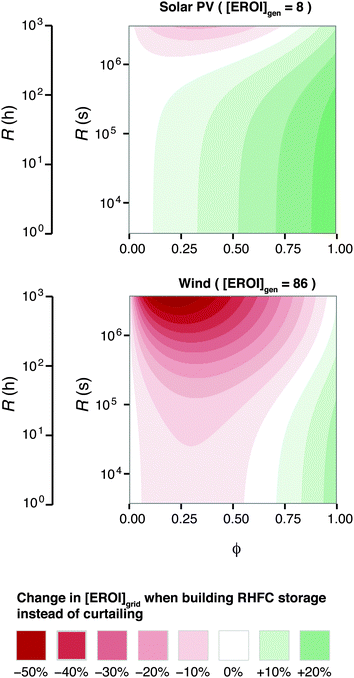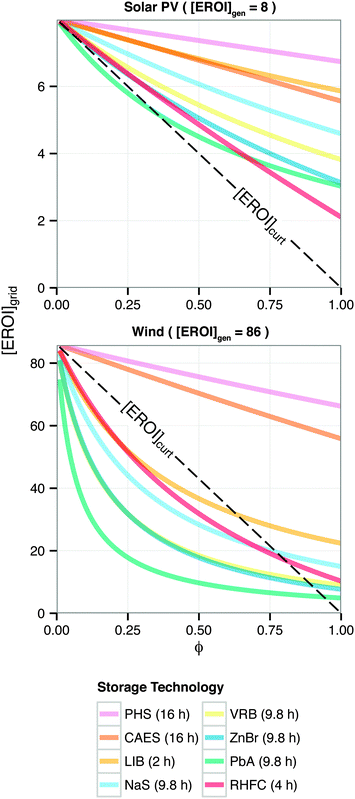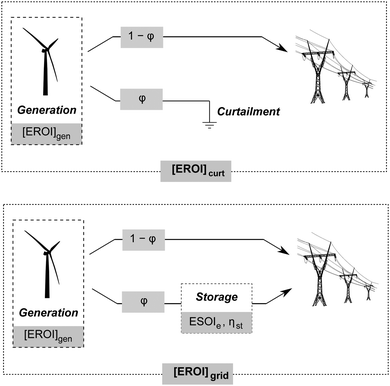Hydrogen or batteries for grid storage? A net energy analysis†
http://pubs.rsc.org/en/content/articlehtml/2015/ee/c4ee04041d
...
3.3 Net energy analysis of hydrogen storage versus curtailment for renewables overgeneration
Grid-scale energy storage can avoid wasteful curtailment and allow greater total energy output from an intermittent generation facility. However, constructing the energy storage requires an energy input. Net energy analysis can determine when the energy benefit of avoiding curtailment outweighs the energy cost of building new storage capacity.24
We consider a generating facility that experiences overgeneration, and we wish to determine whether installing energy storage will provide a net energy benefit over curtailment. The generating facility itself has an energy return on investment of [EROI]gen. Due to overgeneration, a fraction ϕ of the generated power must be diverted away from transmission. This diverted power may be stored for later use, or curtailed and lost (Fig. 5).
When generation is curtailed (and not stored), the EROI of the generation source decreases to
| [EROI]curt = (1 − ϕ)[EROI]gen | (23) |
 | (24) |
Both [EROI]curt and [EROI]grid are always less than [EROI]gen. However, [EROI]grid may be greater or less than [EROI]curt, depending on the characteristics of the storage technology used. The choice of whether to build storage or accept curtailment therefore depends on the ESOIe ratio, as well as on the efficiency of the storage facility, the EROI of the generation technology, and the expected diversion ratio ϕ (eqn (24)).
The decision of whether to store or curtail depends on which quantity is greater, [EROI]curt or [EROI]grid. By scaling this difference to [EROI]gen, we can quantify the benefit of storage, relative to curtailment, across different generating technologies with different values of [EROI]gen.
 | (25) |
When this quantity is positive, building new energy storage capacity will yield a greater overall return on the energy invested in building the entire grid. When this quantity is negative, curtailing the overgeneration will yield a greater overall return on the energy investment, because the energy cost of building the storage facility outweighs the benefit of storing the energy for deferred use.
Because [EROI]grid is a function of the ESOIe ratio, and the ESOIe ratio of a RHFC system is in turn a function of the energy-to-power ratio R, the relative benefit of storing overgeneration in a RHFC system depends on the energy-to-power ratio of the RHFC system (Fig. 6).
 | ||
| Fig. 6 Energy cost/benefit analysis of building the reference case hydrogen energy storage system to store overgeneration instead of curtailing it. Calculated from eqn (25). | ||
For RHFC systems with low values of R, storing overgeneration from a photovoltaic system provides a net energy benefit over curtailing when the diversion ratio is above approximately 10%. At R values above 100 h (providing 47 h of continuous dispatch in our reference system), RHFC storage becomes breakeven at intermediate diversion ratios, yielding neither an energy cost nor an energy benefit compared to curtailment. However, for power from wind farms, RHFC storage is unfavorable except at high diversion ratios (ϕ > 0.75).
Barnhart et al. recently examined the net energy impacts of building storage versus accepting curtailment for a variety of geologic and battery storage technologies coupled with wind turbines and photovoltaic panels.24 These included pumped hydro (PHS) and compressed air (CAES) as well as lithium ion (LIB), sodium sulfur (NaS), vanadium (VRB), zinc bromine (ZnBr), and lead acid (PbA) batteries. Here, we extend this analysis with the corresponding results for a RHFC system (Fig. 7). The RHFC system analyzed for this comparison is identical to the reference system (Table 1) except that it contains 22 MW h (8.0 × 104 MJ) of hydrogen storage capacity, which provides four hours of discharge (R = 8.5 h). The maximum dispatch time assumed in this analysis varies for each technology, and is specified in the legend of Fig. 7.¶¶
 | ||
| Fig. 7 Energy cost/benefit analysis of storing energy using different storage technologies. Calculated from eqn (24). Adapted from ref. 24. | ||
For wind overgeneration, building the reference case RHFC system results in a [EROI]grid equal to the corresponding result for a building a LIB storage system, and more favorable than for other battery technologies. However, the [EROI]grid for any non-geological storage option is lower than [EROI]curt for ϕ < 0.50. In contrast, for photovolatic overgeneration, RHFC storage is less favorable than LIB or NaS, but preferable to curtailing.

Комментариев нет:
Отправить комментарий
Примечание. Отправлять комментарии могут только участники этого блога.